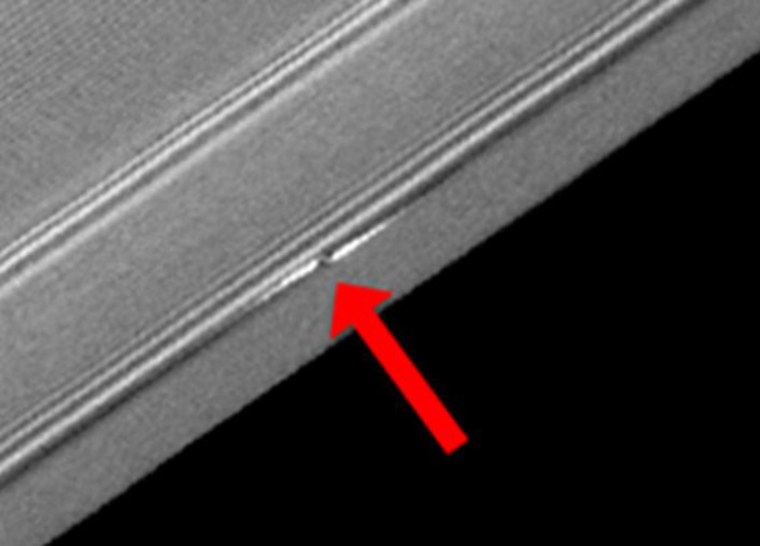Giant propeller-shaped structures have been discovered in the rings of Saturn and appear to be created by a new class of hidden moons, NASA announced Thursday.
NASA's Cassini spacecraft spotted the distinctive structures inside some of Saturn's rings, marking the first time scientists have managed to track the orbits of individual objects from within a debris disk like the one that makes up Saturn's complicated ring system.
"Observing the motions of these disk-embedded objects provides a rare opportunity to gauge how the planets grew from, and interacted with, the disk of material surrounding the early sun," said the study's co-author Carolyn Porco, one of the lead researchers on the Cassini imaging team based at the Space Science Institute in Boulder, Colo. "It allows us a glimpse into how the solar system ended up looking the way it does."
Photos of the propellers taken by Cassini show them to be huge structures several thousands of miles long. By understanding how they form, astronomers hope to glean insight into the debris disks around other stars as well, researchers said.
The results of the study are detailed in the July 8 issue of the journal Astrophysical Journal Letters.
Propellers at Saturn
Cassini scientists have seen double-armed propeller structures in Saturn's rings before, but on a smaller scale than the larger, newfound features. They were first spotted in 2006 in an area now known as the "propeller belt," which is located in the middle of Saturn's outermost dense ring the A ring.
The propellers are actually gaps in the ring material were created by a new class of objects, called moonlets, that are smaller than known moons but larger than the particles making up Saturn's rings. It is estimated that these moonlets could number in the millions, according to Cassini scientists.
The moonlets clear the space immediately around them to generate the propeller-like features, but are not large enough to sweep clear their entire orbit around Saturn, as seen with the moons Pan and Daphnis. (Photos of Saturn rings and moons.)
But in the new study, researchers a new legion of larger and rarer moons in a separate part of the A ring, farther out from Saturn. These much larger moons create propellers that are hundreds of times larger than those previously described, and these objects have been tracked for about four years.
The study was led by Cassini imaging team associate Matthew Tiscareno at Cornell University in Ithaca, N.Y.
The propeller features for these larger moons are up to thousands of miles long and several miles wide. The moons embedded in Saturn's rings appear to kick up ring material as high as 1,600 feet above and below the ring plane.
This is much greater than the typical ring thickness of about 30 feet, researchers said.
Hidden Saturn moons
Still, the Cassini spacecraft is too far away to see the moons amid the swirling ring material that surrounds them. Yet, scientists estimate that the moons measure approximately half a mile in diameter, based on the size of the propellers.
According to their research, Tiscareno and his colleagues estimate that there are dozens of these giant propellers. In fact, 11 of them were imaged multiple times between 2005 and 2009.
One such propeller, nicknamed Bleriot after the famous aviator Louis Bleriot, has shown up in more than 100 separate Cassini images and one ultraviolet imaging spectrograph observation during this time.
"Scientists have never tracked disk-embedded objects anywhere in the universe before now," said Tiscareno. "All the moons and planets we knew about before orbit in empty space. In the propeller belts, we saw a swarm in one image and then had no idea later on if we were seeing the same individual objects. With this new discovery, we can now track disk-embedded moons individually over many years."
Over their four years of observation, the researchers noticed shifts in the orbits of the giant propellers as they travel around Saturn, but the cause of these disturbances have not yet been determined.
The shifting orbits could be caused by collisions with other smaller ring particles, or could be responses to these particles' gravity, the researchers said. The orbital paths of these moonlets could also be altered due to the gravitational attraction of large moons outside of Saturn's rings.
Scientists will continue to monitor the moons to see if the disk itself is driving the chances, similar to the interactions that occur in young solar systems. If so, Tiscareno said, this would be the first time such a measurement has been made directly.
"Propellers give us unexpected insight into the larger objects in the rings," said Linda Spilker, Cassini project scientist based at NASA's Jet Propulsion Laboratory in Pasadena, Calif. "Over the next seven years, Cassini will have the opportunity to watch the evolution of these objects and to figure out why their orbits are changing."
NASA launched the Cassini probe in 1997 and it arrived at Saturn in 2004, where it dropped the European Huygens probe on the cloudy surface of Titan, Saturn's largest moon. Cassini was slated to be decommissioned in September of this year, but received a life extension that now runs through 2017.
